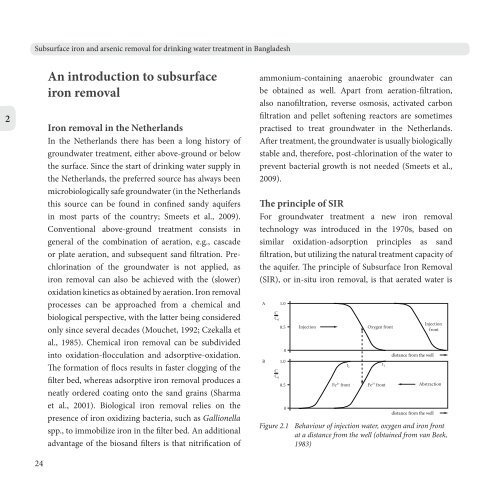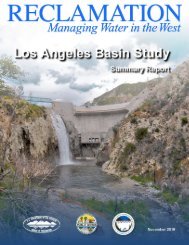Subsurface Iron and Arsenic Removal
qj78kp8
qj78kp8
- No tags were found...
You also want an ePaper? Increase the reach of your titles
YUMPU automatically turns print PDFs into web optimized ePapers that Google loves.
<strong>Subsurface</strong> iron <strong>and</strong> arsenic removal for drinking water treatment in Bangladesh<br />
2<br />
An introduction to subsurface<br />
iron removal<br />
<strong>Iron</strong> removal in the Netherl<strong>and</strong>s<br />
In the Netherl<strong>and</strong>s there has been a long history of<br />
groundwater treatment, either above-ground or below<br />
the surface. Since the start of drinking water supply in<br />
the Netherl<strong>and</strong>s, the preferred source has always been<br />
microbiologically safe groundwater (in the Netherl<strong>and</strong>s<br />
this source can be found in confined s<strong>and</strong>y aquifers<br />
in most parts of the country; Smeets et al., 2009).<br />
Conventional above-ground treatment consists in<br />
general of the combination of aeration, e.g., cascade<br />
or plate aeration, <strong>and</strong> subsequent s<strong>and</strong> filtration. Prechlorination<br />
of the groundwater is not applied, as<br />
iron removal can also be achieved with the (slower)<br />
oxidation kinetics as obtained by aeration. <strong>Iron</strong> removal<br />
processes can be approached from a chemical <strong>and</strong><br />
biological perspective, with the latter being considered<br />
only since several decades (Mouchet, 1992; Czekalla et<br />
al., 1985). Chemical iron removal can be subdivided<br />
into oxidation-flocculation <strong>and</strong> adsorptive-oxidation.<br />
The formation of flocs results in faster clogging of the<br />
filter bed, whereas adsorptive iron removal produces a<br />
neatly ordered coating onto the s<strong>and</strong> grains (Sharma<br />
et al., 2001). Biological iron removal relies on the<br />
presence of iron oxidizing bacteria, such as Gallionella<br />
spp., to immobilize iron in the filter bed. An additional<br />
advantage of the bios<strong>and</strong> filters is that nitrification of<br />
ammonium-containing anaerobic groundwater can<br />
be obtained as well. Apart from aeration-filtration,<br />
also nanofiltration, reverse osmosis, activated carbon<br />
filtration <strong>and</strong> pellet softening reactors are sometimes<br />
practised to treat groundwater in the Netherl<strong>and</strong>s.<br />
After treatment, the groundwater is usually biologically<br />
stable <strong>and</strong>, therefore, post-chlorination of the water to<br />
prevent bacterial growth is not needed (Smeets et al.,<br />
2009).<br />
The principle of SIR<br />
For groundwater treatment a new iron removal<br />
technology was introduced in the 1970s, based on<br />
similar oxidation-adsorption principles as s<strong>and</strong><br />
filtration, but utilizing the natural treatment capacity of<br />
the aquifer. The principle of <strong>Subsurface</strong> <strong>Iron</strong> <strong>Removal</strong><br />
(SIR), or in-situ iron removal, is that aerated water is<br />
A<br />
B<br />
1.0<br />
C<br />
C 0<br />
Injection Oxygen front<br />
C<br />
C 0<br />
0.5<br />
0<br />
1.0<br />
0.5<br />
0<br />
Injection<br />
front<br />
distance from the well<br />
Fe 2+ front Fe 2+ front<br />
Abstraction<br />
t 2<br />
t 1<br />
distance from the well<br />
Figure 2.1 Behaviour of injection water, oxygen <strong>and</strong> iron front<br />
at a distance from the well (obtained from van Beek,<br />
1983)<br />
24



